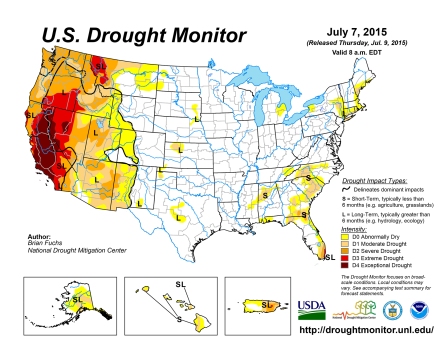 From the Pacific Northwest down to the California-Mexico border, the western US is in a prolonged state of drought, ranking anywhere between “Moderate” to “Exceptional” according to the US Drought Monitor (see Figure 1). Similar conditions are now creeping eastward, almost completely enveloping Nevada, Arizona, Utah, Idaho and Wyoming. The insidious fingers of drought are even reaching into states where recent heavy rainfall has been making headlines.
From the Pacific Northwest down to the California-Mexico border, the western US is in a prolonged state of drought, ranking anywhere between “Moderate” to “Exceptional” according to the US Drought Monitor (see Figure 1). Similar conditions are now creeping eastward, almost completely enveloping Nevada, Arizona, Utah, Idaho and Wyoming. The insidious fingers of drought are even reaching into states where recent heavy rainfall has been making headlines.
Saving water is like saving money. Cutting back only when it’s scarce doesn’t make sense and is, at best, shortsighted. In the case of water, which we know to be a limited resource, striving for the optimum management of water resources makes sense all the time and sets the stage for survival in future “times of need”.
There are lots of ways to save water. For consumers, it includes limiting outdoor watering, taking shorter showers, using low usage appliances and planting drought resistant landscape instead of water guzzling turf. For water companies, water saving measures vary based on systems and resources. There is, however, one solution than can be successfully implemented in nearly all water distribution systems: Pressure Optimization.
Top Ten Reasons Why Water Companies Should Try Pressure Optimization
- Reducing pressure will result in lower usage, minimize leaks and reduce the incidence of pipe breaks.
- Standard Pressure Reducing Valves (PRVs) control to a constant pressure set point at a valve outlet, regardless of changing flow rates and/or varying inlet pressure.
- When using standard PRVs, as demand decreases, overall system pressure will rise. This is due to less friction in the piping network.
- This rise in system pressure becomes a silent water thief. It increases water usage, delivering more water than is needed every time a consumer turns on the tap, runs their sprinkler system, etc…
- Increased pressure also stresses pipes resulting in leaks and more frequent pipe breaks.
- Pressure Optimization allows the delivery of only the pressure required to meet actual demand, no more, no less
- The good news is that in, most cases, pressure optimization has little or no impact on the consumer.
- A Pressure Optimization package on a PRV allows the valve to immediately react to a change in demand.
- There are two basic approaches to Pressure Optimization: Electronic and Hydraulic. Both of which can be implemented using existing valves in a distribution system.
- For the electronic approach, existing PRVs are retrofitted with motorized pilots and the VC-22D Valve Controller with a pre-loaded Pressure Optimization App. This app allows the user to build a customized pressure versus flow curve, which can then be implemented in the system.
- For the hydraulic approach to Pressure Optimization, a standard PRV can be retrofitted with a 98 Series Pilot System. This system will allow the valve to shift from higher pressure to a lower pressure at a specific corresponding flow rate.
- Cla-Val’s Pressure Optimization Solutions will save water.
The Time to Save Water is NOW!
Need further proof that it works? Pressure Optimization (AKA Pressure Management) has been successfully implemented as a water savings tool around the world including The United Kingdom, France, Latin America, South Africa, New Zealand and Australia. Contact Cla-Val today and ask to have your system parameters entered into our Pressure Optimizer Calculator, to start saving water now.
Contact: digital@cla-val.com or call 800.722.4866. www.cla-val.com

Its amazing But its true water is the number 1 problem all over the world from china to india. Companies involved in this business should do very well over the next 20 or 30 years
LikeLike